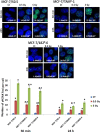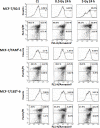Altered radiation responses of breast cancer cells resistant to hormonal therapy
- PMID: 25682200
- PMCID: PMC4359324
- DOI: 10.18632/oncotarget.3188
Altered radiation responses of breast cancer cells resistant to hormonal therapy
Abstract
Endocrine therapy agents (the selective estrogen receptor (ER) modulators such as tamoxifen or the selective ER down-regulators such as ICI 182,780) are key treatment regimens for hormone receptor-positive breast cancers. While these drugs are very effective in controlling ER-positive breast cancer, many tumors that initially respond well to treatment often acquire drug resistance, which is a major clinical problem. In clinical practice, hormonal therapy agents are commonly used in combination or sequence with radiation therapy. Tamoxifen treatment and radiotherapy improve both local tumor control and patient survival. However, tamoxifen treatment may render cancer cells less responsive to radiation therapy. Only a handful of data exist on the effects of radiation on cells resistant to hormonal therapy agents. These scarce data show that cells that were resistant to tamoxifen were also resistant to radiation. Yet, the existence and mechanisms of cross-resistance to endocrine therapy and radiation therapy need to be established. Here, we for the first time examined and compared radiation responses of MCF-7 breast adenocarcinoma cells (MCF-7/S0.5) and two antiestrogen resistant cell lines derived from MCF-7/S0.5: the tamoxifen resistant MCF-7/TAMR-1 and ICI 182,780 resistant MCF-7/182R-6 cell lines. Specifically, we analyzed the radiation-induced changes in the expression of genes involved in DNA damage, apoptosis, and cell cycle regulation. We found that the tamoxifen-resistant cell line in contrast to the parental and ICI 182,780-resistant cell lines displayed a significantly less radiation-induced decrease in the expression of genes involved in DNA repair. Furthermore, we show that MCF-7/TAMR-1 and MCF-7/182R-6 cells were less susceptible to radiation-induced apoptosis as compared to the parental line. These data indicate that tamoxifen-resistant breast cancer cells have a reduced sensitivity to radiation treatment. The current study may therefore serve as a roadmap to the future analysis of the mechanisms of cross-resistance between hormonal therapy and radiation.
Figures





Similar articles
-
Altered expression of estrogen-regulated genes in a tamoxifen-resistant and ICI 164,384 and ICI 182,780 sensitive human breast cancer cell line, MCF-7/TAMR-1.Cancer Res. 1994 Mar 15;54(6):1587-95. Cancer Res. 1994. PMID: 8137264
-
MCF7/LCC9: an antiestrogen-resistant MCF-7 variant in which acquired resistance to the steroidal antiestrogen ICI 182,780 confers an early cross-resistance to the nonsteroidal antiestrogen tamoxifen.Cancer Res. 1997 Aug 15;57(16):3486-93. Cancer Res. 1997. PMID: 9270017
-
Changes in DNA Damage Repair Gene Expression and Cell Cycle Gene Expression Do Not Explain Radioresistance in Tamoxifen-Resistant Breast Cancer.Oncol Res. 2020 Feb 7;28(1):33-40. doi: 10.3727/096504019X15555794826018. Epub 2019 Apr 18. Oncol Res. 2020. PMID: 31046897 Free PMC article.
-
[Interactions between radiation and hormonal therapy in breast cancer: simultaneous or sequential treatment].Orv Hetil. 2006 Jan 22;147(3):121-5. Orv Hetil. 2006. PMID: 16515031 Review. Hungarian.
-
Mechanisms of tamoxifen resistance in the treatment of advanced breast cancer.Acta Oncol. 1996;35 Suppl 5:9-14. doi: 10.3109/02841869609083961. Acta Oncol. 1996. PMID: 9142958 Review.
Cited by
-
Paclitaxel-Based Chemotherapy Targeting Cancer Stem Cells from Mono- to Combination Therapy.Biomedicines. 2021 May 2;9(5):500. doi: 10.3390/biomedicines9050500. Biomedicines. 2021. PMID: 34063205 Free PMC article. Review.
-
Mechanisms of dihydrotestosterone action on resveratrol-induced anti-proliferation in breast cancer cells with different ERα status.Oncotarget. 2015 Nov 3;6(34):35866-79. doi: 10.18632/oncotarget.5482. Oncotarget. 2015. PMID: 26456774 Free PMC article.
-
Combinatorial high-throughput experimental and bioinformatic approach identifies molecular pathways linked with the sensitivity to anticancer target drugs.Oncotarget. 2015 Sep 29;6(29):27227-38. doi: 10.18632/oncotarget.4507. Oncotarget. 2015. PMID: 26317900 Free PMC article.
-
A dual role of miR-22 modulated by RelA/p65 in resensitizing fulvestrant-resistant breast cancer cells to fulvestrant by targeting FOXP1 and HDAC4 and constitutive acetylation of p53 at Lys382.Oncogenesis. 2018 Jul 30;7(7):54. doi: 10.1038/s41389-018-0063-5. Oncogenesis. 2018. PMID: 30057418 Free PMC article.
-
Irreversible inhibition of estrogen receptor α signaling and the emergence of hormonal resistance in MCF7 breast cancer cells induced by DNA damage agents.Biomed Rep. 2024 Jan 19;20(3):42. doi: 10.3892/br.2024.1727. eCollection 2024 Mar. Biomed Rep. 2024. PMID: 38343657 Free PMC article.
References
-
- Moy B, Goss PE. Estrogen receptor pathway: resistance to endocrine therapy and new therapeutic approaches. Clin Cancer Res. 2006;12(16):4790–4793. - PubMed
-
- Robertson JF. Fulvestrant (Faslodex) -- how to make a good drug better. Oncologist. 2007;12(7):774–784. - PubMed
-
- Hutcheson IR, Knowlden JM, Madden TA, Barrow D, Gee JM, Wakeling AE, Nicholson RI. Oestrogen receptor-mediated modulation of the EGFR/MAPK pathway in tamoxifen-resistant MCF-7 cells. Breast Cancer Res Treat. 2003;81(1):81–93. - PubMed
Publication types
MeSH terms
Substances
Grants and funding
LinkOut - more resources
Full Text Sources
Other Literature Sources
Medical

